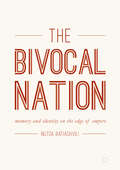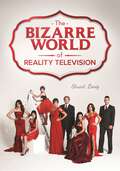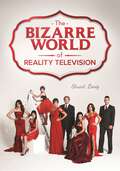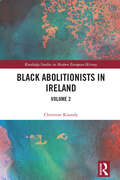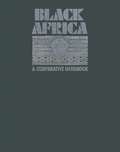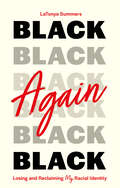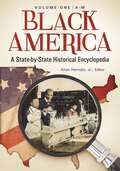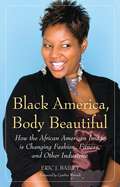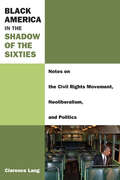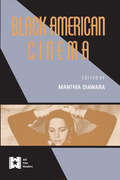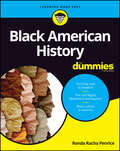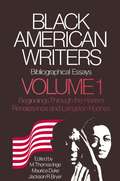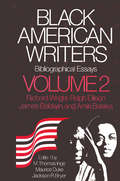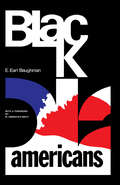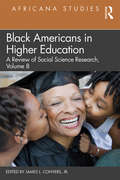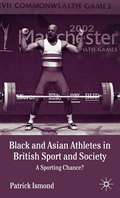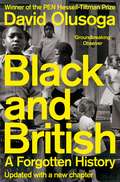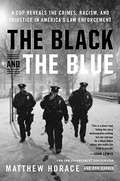- Table View
- List View
The Bivocal Nation: Memory and Identity on the Edge of Empire
by Nutsa BatiashviliThis book is about a divided nation and polarized nationhood. Its principal purpose is to examine division and polarization as forms of imagining that are configured within culture and framed by history. This is what bivocality signifies—two distinct discursive voices through which nationhood is articulated; voices that are nonetheless grounded in a culturally common symbolic field. The volume offers an ethnographically centered analysis of the ways in which Georgians make use of these voices in critical discourses of nationhood. By illuminating the cultural semantics behind these discourses, Nutsa Batiashvili offers a new constellation of conceptual terms for understanding modern forms of nationalism and nation-building in the marginal or liminal landscapes between the Orient and the Occident.
The Bizarre World of Reality Television
by Stuart LenigHow do reality television programs shape our view of the world and what we perceive as real and normal? This book explores the bizarre and highly controversial world of reality television, including its early history, wide variety of subject matter, and social implications.In recent decades, reality television shows ranging from Keeping up with the Kardashians to Duck Dynasty have become increasingly popular. Why are these "unscripted" programs irresistible to millions of viewers? And what does the nearly universal success of reality shows say about American culture? This book covers more than 100 major and influential reality programs past and present, discussing the origins and past of reality programming, the contemporary social and economic conditions that led to the rise of reality shows, and the ways in which the most successful shows achieve popularity with both male and female demographics or appeal to specific, targeted niche audiences.The text addresses reality TV within five, easy-to-identify content categories: competition shows, relationship/love-interest shows, real people or alternative lifestyle and culture shows, transformation shows, and international programming. By examining modern reality television, a topic of great interest for a wide variety of readers, this book also discusses cultural and social norms in the United States, including materialism, unrealistic beauty ideals, gender roles and stereotypes in society, dynamics of personal relationships, teenage lifestyles and issues, and the branding of people for financial gain and wider viewership.
The Bizarre World of Reality Television
by Stuart LenigHow do reality television programs shape our view of the world and what we perceive as real and normal? This book explores the bizarre and highly controversial world of reality television, including its early history, wide variety of subject matter, and social implications.In recent decades, reality television shows ranging from Keeping up with the Kardashians to Duck Dynasty have become increasingly popular. Why are these "unscripted" programs irresistible to millions of viewers? And what does the nearly universal success of reality shows say about American culture? This book covers more than 100 major and influential reality programs past and present, discussing the origins and past of reality programming, the contemporary social and economic conditions that led to the rise of reality shows, and the ways in which the most successful shows achieve popularity with both male and female demographics or appeal to specific, targeted niche audiences.The text addresses reality TV within five, easy-to-identify content categories: competition shows, relationship/love-interest shows, real people or alternative lifestyle and culture shows, transformation shows, and international programming. By examining modern reality television, a topic of great interest for a wide variety of readers, this book also discusses cultural and social norms in the United States, including materialism, unrealistic beauty ideals, gender roles and stereotypes in society, dynamics of personal relationships, teenage lifestyles and issues, and the branding of people for financial gain and wider viewership.
Black 1919: Riots, Racism and Resistance in Imperial Britain (Postcolonialism Across the Disciplines #5)
by Jacqueline JenkinsonThe riots that broke out in various British port cities in 1919 were a dramatic manifestation of a wave of global unrest that affected Britain, parts of its empire, continental Europe and North America during and in the wake of the First World War. During the riots, crowds of white working-class people targeted black workers, their families and black-owned businesses and property. One of the chief sources of violent confrontation in the run-down port areas was the ‘colour’ bar implemented by the sailors’ trades unions campaigning to keep black, Arab and Asian sailors off British ships in a time of increasing job competition. Black 1919 sets out the economic and social causes of the riots and their impact on Britain’s relationship with its empire and its colonial subjects. The riots are also considered within the wider context of rioting elsewhere on the fringes of the Atlantic world as black people came in increased numbers into urban and metropolitan settings where they competed with working-class white people for jobs and housing during and after the First World War. The book details the events of the port riots in Britain, with chapters devoted to assessing the motivations and make-up of the rioting crowds, examining police procedures during the riots, considering the court cases that followed, and looking at the longer-term consequences for the black British workers and their families. Black 1919 is a stark and timely reminder of the violent racist conflict that emerged after the First World War and the shockwaves that reverberated around the Empire.
Black '47: Britain and the Famine Irish
by F. NealThe Irish Famine of 1845-49 was a major modern catastrophe. The return of the potato blight in 1846 triggered a huge exodus of destitute Irish seeking refuge in British towns and 1847 witnessed an unprecedented inflow of Irish refugees into Britain. This book examines the scale of that refugee immigration, the conditions under which the refugees were carried to Britain, the relief operations mounted, the horrors of the typhus epidemic in Liverpool, Glasgow, Manchester, South Wales and the North-East, and the financial cost to the British ratepayers.
Black Abolitionists in Ireland: Volume 2 (Routledge Studies in Modern European History)
by Christine KinealyBuilding on the narratives explored in volume one, this publication recovers the story of a further seven Black visitors to Ireland in the decades prior to the American Civil War.This volume examines each of these seven activists and artists, and how their unique and diverse talents contributed to the movement to abolish enslavement and to the demand for Black equality. In an era that witnessed the rise of minstrelsy, they provided a powerful counter argument to the lie of Black inferiority. Moreover, their interactions with Irish abolitionists helped to build a strong transatlantic movement that had a global reach and impact. The lives explored are: Ira Aldridge (the African Roscius), William Henry Lane (Master Juba), William P. Powell, Elizabeth Greenfield (the Black Swan), Reuben Nixon, James Watkins and William H. Day. Individually and collectively they demonstrated the agency and power of Black involvement in the search for social justice.This book will be of value to students and scholars alike interested in modern European history and social and cultural history.
Black Abolitionists in Ireland: Volume 2 (Routledge Studies in Modern European History)
by Christine KinealyBuilding on the narratives explored in volume one, this publication recovers the story of a further seven Black visitors to Ireland in the decades prior to the American Civil War.This volume examines each of these seven activists and artists, and how their unique and diverse talents contributed to the movement to abolish enslavement and to the demand for Black equality. In an era that witnessed the rise of minstrelsy, they provided a powerful counter argument to the lie of Black inferiority. Moreover, their interactions with Irish abolitionists helped to build a strong transatlantic movement that had a global reach and impact. The lives explored are: Ira Aldridge (the African Roscius), William Henry Lane (Master Juba), William P. Powell, Elizabeth Greenfield (the Black Swan), Reuben Nixon, James Watkins and William H. Day. Individually and collectively they demonstrated the agency and power of Black involvement in the search for social justice.This book will be of value to students and scholars alike interested in modern European history and social and cultural history.
Black Africa: A Comparative Handbook
by Robert C. Mitchell Donald G. Morrison John N. PadenBlack Africa presents political, economic and social data for 41 black African nations. The first edition was published in 1972 and included only data on 32 countries - which was the total number of independent African nations at that time. Enlarging on the first edition, this second edition covers in detail important aspects of the countries included, from demography to political development and social mobilization to a modern comparative analysis of African states. Black Africa is a complete and comprehensive handbook. The first edition of Black Africa won a Book of the Year Award from the American Library Association.
Black Again: Losing and Reclaiming My Racial Identity
by LaTonya Summers"I was driven by the belief that if I wanted to go somewhere I'd need to be something other than Black."LaTonya Summers was only six years old the first time she unconsciously tried to be "more white". Recollecting experiences from her childhood in foster care through to her life today as an Assistant Professor and mother, LaTonya examines how her perception of self was affected by internalized racism and led her to adopt white norms - influencing everything from her music and clothing choices to her speech and values. Join LaTonya in her journey of realization - how all those years assimilating, stretching and pressing for whiteness harmed her, and how, in a world that sees her as Black, it's about time she did too. Discover how LaTonya has truly "made it" by embracing and endorsing the Afrocentric norms and values that have sustained her and her family better than any white picket fence ever could.
Black Again: Losing and Reclaiming My Racial Identity
by LaTonya Summers"I was driven by the belief that if I wanted to go somewhere I'd need to be something other than Black."LaTonya Summers was only six years old the first time she unconsciously tried to be "more white". Recollecting experiences from her childhood in foster care through to her life today as an Assistant Professor and mother, LaTonya examines how her perception of self was affected by internalized racism and led her to adopt white norms - influencing everything from her music and clothing choices to her speech and values. Join LaTonya in her journey of realization - how all those years assimilating, stretching and pressing for whiteness harmed her, and how, in a world that sees her as Black, it's about time she did too. Discover how LaTonya has truly "made it" by embracing and endorsing the Afrocentric norms and values that have sustained her and her family better than any white picket fence ever could.
Black America [2 volumes]: A State-by-State Historical Encyclopedia [2 volumes]
This two-volume encyclopedia presents a state-by-state history of African Americans in the 50 states and the District of Columbia.African American populations are established in every area of the United States, including Hawaii and Alaska (more than10 percent of the population of Fairbanks, Alaska, is African American). Black Americans have played an invaluable role in creating our great nation in myriad ways, including their physical contributions and labor during the slavery era; intellectually, spiritually, and politically; in service to our country in military duty; and in areas of popular culture such as music, art, sports, and entertainment.The chapters extend chronologically from the colonial period to the present. Each chapter presents a timeline of African American history in the state, a historical overview, notable African Americans and their pioneering accomplishments, and state-specific traditions or activities. This state-by-state treatment of information allows readers to take pride in what happened in their state and in the famous people who came from their state.
Black America, Body Beautiful: How the African American Image is Changing Fashion, Fitness, and Other Industries (Non-ser.)
by Eric J. BaileyDespite all the medical and media attention focused on the rate of overweight and obesity in the African American population, African American images and body types are greatly influencing changes in the fashion, fitness, advertising, television and movie industries. This is because overweight, like beauty, can be in the eye of the beholder. Most research studies investigating attitudes about body image and body type among African Americans have shown they are more satisfied with their bodies than are their white counterparts and that there appears to be a wider range of acceptable body shapes and weights, and a more flexible standard of attractiveness, among black Americans as compared to whites. That fact is not being lost on leaders of industries that might profit from understanding this wider range of beauty, as well as playing to it. In this book, medical anthropologist Eric Bailey introduces and explains the self-acceptance and body image satisfaction of African Americans, and traces how that has spurred changes in industry. His book fills the void of scientific evidence to enhance the understanding of African Americans' perceptions related to body image and beauty—and is the first to document these issues from the perspective of an African American male.Despite all the medical and media attention focused on the rate of overweight and obesity in the African American population, African American images and body types are greatly influencing changes in the fashion, fitness, advertising, television, and movie industries. This is because overweight, like beauty, can be in the eye of the beholder. Most research studies investigating attitudes about body image and body type among African Americans have shown they are more satisfied with their bodies than are their white counterparts. Most black women, for example, are of course concerned with how they look, but do not judge themselves in terms of their weight and do not believe they are valued mostly on the basis of their bodies. Black teen girls most often say being thick and curvaceous with large hips and ample thighs is seen as the most desirable body shape. Thus, there appears to be a wider range of acceptable body shapes and weights, and a more flexible standard of attractiveness, among black Americans as compared to whites. That fact is not lost on leaders of industries that might profit from understanding this wider range of beauty, as well as playing to it. Voluptuous supermodel Tyra Banks is just one African American who's broken the mold in that industry. The effects have been seen right down to department and local clothes stores, where lines of larger and plus-size fashions are expanding, becoming more colorful and more ornate. In the fitness industry, health gurus Madonna Grimes and Billy Blanks have been revolutionizing how people get fit and how fitness needs to be redeveloped for the African American population. Advertising has taken a similar turn, not the least manifestation of which were the major campaigns Dove and Nike ran in 2005 with plus-sized actresses (who continue to appear in promotions for both companies). In movies and on television shows, the African American beautiful body image has followed suit.In this book, medical anthropologist Eric Bailey introduces and explains the self-acceptance and body image satisfaction of African Americans, and traces how that has spurred changes in industry. His book fills the void of scientific evidence to enhance the understanding of African Americans' perceptions related to body image and beauty—and is the first to document these issues from the perspective of an African American male.
Black America in the Shadow of the Sixties: Notes on the Civil Rights Movement, Neoliberalism, and Politics (Class : Culture)
by Clarence LangThe 1960s, including the black social movements of the period, are an obstacle to understanding the current conditions of African Americans, argues Clarence Lang. While Americans celebrate the current anniversaries of various black freedom milestones and the election of the first black president, the effects of neoliberalism since the 1970s have been particularly devastating to African Americans. Neoliberalism, which rejects social welfare protections in favor of individual liberty, unfettered markets, and a laissez-faire national state, has produced an environment in which people of color struggle with unstable employment, declining family income, rising household debt, increased class stratification, and heightened racial terrorism and imprisonment. The book argues that a reassessment of the Sixties and its legacies is necessary to make better sense of black community, leadership, politics, and the prospects for social change today. Combining interdisciplinary scholarship, political reportage, and personal reflection, this work sheds powerful light on the forces underlying the stark social and economic circumstances facing African Americans today, as well as the need for cautious optimism alongside sober analysis.
Black American Cinema
by Manthia DiawaraThis is the first major collection of criticism on Black American cinema. From the pioneering work of Oscar Micheaux and Wallace Thurman to the Hollywood success of Spike Lee, Black American filmmakers have played a remarkable role in the development of the American film, both independent and mainstream.In this volume, the work of early Black filmmakers is given serious attention for the first time. Individual essays consider what a Black film tradition might be, the relation between Black American filmmakers and filmmakers from the diaspora, the nature of Black film aesthetics, the artist's place within the community, and the representation of a Black imaginary. Black American Cinema also uncovers the construction of Black sexuality on screen, the role of Black women in independent cinema, and the specific question of Black female spectatorship. A lively and provocative group of essays debate the place and significance of Spike LeeOf crucial importance are the ways in which the essays analyze those Black directors who worked for Hollywood and whose films are simplistically dismissed as sell-outs, to the Hollywood "master narrative," as well as those "crossover" filmmakers whose achievements entail a surreptitious infiltration of the studios. Black American Cinema demonstrates the wealth of the Black contribution to American film and the complex course that contribution has taken.Contributors: Houston Baker, Jr., Toni Cade Bambara, Amiri Baraka, Jacquie Bobo, Richard Dyer, Jane Gaines, Henry Louis Gates, Jr., Ron Green, Ed Guerrero, bell hooks, Phyllis Klotman, Ntongele Masilela, Clyde Taylor, and Michele Wallace.
Black American Cinema
by Manthia DiawaraThis is the first major collection of criticism on Black American cinema. From the pioneering work of Oscar Micheaux and Wallace Thurman to the Hollywood success of Spike Lee, Black American filmmakers have played a remarkable role in the development of the American film, both independent and mainstream.In this volume, the work of early Black filmmakers is given serious attention for the first time. Individual essays consider what a Black film tradition might be, the relation between Black American filmmakers and filmmakers from the diaspora, the nature of Black film aesthetics, the artist's place within the community, and the representation of a Black imaginary. Black American Cinema also uncovers the construction of Black sexuality on screen, the role of Black women in independent cinema, and the specific question of Black female spectatorship. A lively and provocative group of essays debate the place and significance of Spike LeeOf crucial importance are the ways in which the essays analyze those Black directors who worked for Hollywood and whose films are simplistically dismissed as sell-outs, to the Hollywood "master narrative," as well as those "crossover" filmmakers whose achievements entail a surreptitious infiltration of the studios. Black American Cinema demonstrates the wealth of the Black contribution to American film and the complex course that contribution has taken.Contributors: Houston Baker, Jr., Toni Cade Bambara, Amiri Baraka, Jacquie Bobo, Richard Dyer, Jane Gaines, Henry Louis Gates, Jr., Ron Green, Ed Guerrero, bell hooks, Phyllis Klotman, Ntongele Masilela, Clyde Taylor, and Michele Wallace.
Black American History For Dummies
by Ronda Racha PenriceGo deeper than the Black History you may think you know! Black American History For Dummies reveals the terrors and struggles and celebrates the triumphs of Black Americans. This handy book goes way beyond what you may have studied in school, digging into the complexities and the intrigues that make up Black America. From slavery and the Civil Rights movement to Black Wall Street, Juneteenth, redlining, and Black Lives Matter, this book offers an accessible resource for understanding the facts and events critical to Black history in America. The history of Black Americans is the history of Americans; Americans dance to Black music, read Black literature, watch Black movies, and whether they know it or not reap the benefits of the vibrant political, athletic, and sociological contributions of Black Americans. With this book, you can dive into history, culture, and beyond. See how far there’s yet to go in the approach to studying Black American culture and ending racism. Get the authoritative story on the growth and evolution of Black America from slavery, Reconstruction, Jim Crow, the Civil Rights era through to today Discover the Black artists, musicians, athletes, and leaders who have made the United States what it is Develop a fuller understanding of concerns about police brutality and other front-and-center race issues Find out how every aspect of American life connects to Black history Black American History For Dummies is for anyone who needs to learn or re-learn the true history about Black Americans.
Black American History For Dummies
by Ronda Racha PenriceGo deeper than the Black History you may think you know! Black American History For Dummies reveals the terrors and struggles and celebrates the triumphs of Black Americans. This handy book goes way beyond what you may have studied in school, digging into the complexities and the intrigues that make up Black America. From slavery and the Civil Rights movement to Black Wall Street, Juneteenth, redlining, and Black Lives Matter, this book offers an accessible resource for understanding the facts and events critical to Black history in America. The history of Black Americans is the history of Americans; Americans dance to Black music, read Black literature, watch Black movies, and whether they know it or not reap the benefits of the vibrant political, athletic, and sociological contributions of Black Americans. With this book, you can dive into history, culture, and beyond. See how far there’s yet to go in the approach to studying Black American culture and ending racism. Get the authoritative story on the growth and evolution of Black America from slavery, Reconstruction, Jim Crow, the Civil Rights era through to today Discover the Black artists, musicians, athletes, and leaders who have made the United States what it is Develop a fuller understanding of concerns about police brutality and other front-and-center race issues Find out how every aspect of American life connects to Black history Black American History For Dummies is for anyone who needs to learn or re-learn the true history about Black Americans.
Black American Writers: Bibliographical Essays, Volume 1: The Beginnings through the Harlem Renaissance and Langston Hughes
by Na NaBlack American Writers, Bibliographical Essays, vol 2: Richard Wright, Ralph Ellison, James Baldwin & Amiri Baraka
by Na NaBlack Americans: A Psychological Analysis
by E. Earl BaughmanBlack Americans: A Psychological Analysis describes the psychological processes of black Americans, emphasizing how prejudice and discrimination affect their various behavior patterns. This book discusses the concept of race, intelligence, scholastic performance, self-esteem, rage and aggression, psychopathology, socialization and family, leadership and education of an average black American. Other topics include the social versus biological definitions of race; black-white differences in IQ; channeling black aggression; and incidence of behavioral disturbances among blacks. This text also covers the black-white comparison using the Minnesota Multiphasic Personality Inventory (MMPI) and origins of black families. This publication is addressed to students in a variety of introductory psychology courses—general psychology, personality, and child psychology.
Black Americans in Higher Education: Africana Studies: A Review of Social Science Research, Volume 8
by James L. ConyersNarrating the realities of teacher burnout, the reception of a Black intelligentsia, and HIV awareness in local communities, Black Americans in Higher Education, the eighth volume of Africana Studies, explores higher education across the United States as inextricably related to contemporary issues facing African Americans. Featuring the work of Terrell M. Thomas, Gwendolyn D. Alfred, Kevin B. Thompson, Jasmine Williams, TaNeisha R. Page, Drew D. Brown, Grace A. Loudd, Derek Wilson, DaVonte Lyons, Jacqueline Gerard, Tanisha Stanford, Lanetta Dickens, Brittany C. Slatton, and James L. Conyers, Jr., this collection presents a deeper, cross-cultural understanding of higher education that conveys the many ways its intersections can promote the agency of Black Americans.
Black Americans in Higher Education: Africana Studies: A Review of Social Science Research, Volume 8
by James L. Conyers Jr.Narrating the realities of teacher burnout, the reception of a Black intelligentsia, and HIV awareness in local communities, Black Americans in Higher Education, the eighth volume of Africana Studies, explores higher education across the United States as inextricably related to contemporary issues facing African Americans. Featuring the work of Terrell M. Thomas, Gwendolyn D. Alfred, Kevin B. Thompson, Jasmine Williams, TaNeisha R. Page, Drew D. Brown, Grace A. Loudd, Derek Wilson, DaVonte Lyons, Jacqueline Gerard, Tanisha Stanford, Lanetta Dickens, Brittany C. Slatton, and James L. Conyers, Jr., this collection presents a deeper, cross-cultural understanding of higher education that conveys the many ways its intersections can promote the agency of Black Americans.
Black and Asian Athletes in British Sport and Society: A Sporting Chance?
by P. IsmondIn this innovative study, Patrick Ismond provides an analysis of the issue of racism within British sport. It presents a number of theoretical positions regarding race, racism and sport, before providing a background history of the involvement of minority ethnic communities. Much detailed primary research is used to inform interesting discussions concerning racism in sport and its relationship to ethnicity, identity and notions of Englishness and Britishness. The study also includes a valuable analysis of sexism in sport, and the discrimination suffered by minority ethnic sportswomen.
Black and British: A Forgotten History
by David OlusogaWinner of the 2017 PEN Hessell-Tiltman Prize.Winner of the Longman History Today Trustees' Award.A Waterstones.com History Book of the Year.Longlisted for the Orwell Prize.Shortlisted for the inaugural Jhalak Prize.In this vital re-examination of a shared history, historian and broadcaster David Olusoga tells the rich and revealing story of the long relationship between the British Isles and the people of Africa and the Caribbean. Drawing on new genealogical research, original records, and expert testimony, Black and British reaches back to Roman Britain, the medieval imagination, Elizabethan ‘blackamoors’ and the global slave-trading empire. It shows that the great industrial boom of the nineteenth century was built on American slavery, and that black Britons fought at Trafalgar and in the trenches of both World Wars. Black British history is woven into the cultural and economic histories of the nation. It is not a singular history, but one that belongs to us all.Unflinching, confronting taboos and revealing hitherto unknown scandals, Olusoga describes how the lives of black and white Britons have been entwined for centuries.
The Black and the Blue: A Cop Reveals The Crimes, Racism, And Injustice In America's Law Enforcement
by Matthew Horace Ron HarrisDuring his 28-year career, Matthew Horace rose through the ranks from a police officer working the beat to a federal agent working criminal cases in some of the toughest communities in America to a highly decorated federal law enforcement executive managing high-profile investigations nationwide. Yet it was not until seven years into his service- when Horace found himself face down on the ground with a gun pointed at his head by a white fellow officer-that he fully understood the racism seething within America's police departments. Through gut-wrenching reportage, on-the-ground research, and personal accounts from interviews with police and government officials around the country, Horace presents an insider's examination of archaic police tactics. He dissects some of the nation's most highly publicized police shootings and communities to explain how these systems and tactics have hurt the people they serve, revealing the mistakes that have stoked racist policing, sky-high incarceration rates, and an epidemic of violence.
